
Lepidoptera or lepidopterans is an order of winged insects that includes butterflies and moths. About 180,000 species of the Lepidoptera have been described, representing 10% of the total described species of living organisms, making it the second largest insect order with 126 families and 46 superfamilies, and one of the most widespread and widely recognizable insect orders in the world.

Passiflora, known also as the passion flowers or passion vines, is a genus of about 550 species of flowering plants, the type genus of the family Passifloraceae.

A proboscis is an elongated appendage from the head of an animal, either a vertebrate or an invertebrate. In invertebrates, the term usually refers to tubular mouthparts used for feeding and sucking. In vertebrates, a proboscis is an elongated nose or snout.

Pieris rapae is a small- to medium-sized butterfly species of the whites-and-yellows family Pieridae. It is known in Europe as the small white, in North America as the cabbage white or cabbage butterfly, on several continents as the small cabbage white, and in New Zealand as the white butterfly. The butterfly is recognizable by its white color with small black dots on its wings, and it can be distinguished from P. brassicae by its larger size and the black band at the tip of its forewings.
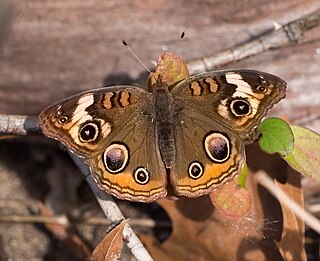
Junonia coenia, known as the common buckeye or buckeye, is a butterfly in the family Nymphalidae. Its range covers much of North America and some of Central America, including most of the eastern half of the US, the lower to middle Midwest, the Southwest, southern Canada, and Mexico. Its habitat is open areas with low vegetation and some bare ground. Its original ancestry has been traced to Africa, which then experiences divergence in Asia. The species Junonia grisea, the gray buckeye, is found west of the Rocky Mountains and was formerly a subspecies of Junonia coenia.

In zoology, a nectarivore is an animal which derives its energy and nutrient requirements from a diet consisting mainly or exclusively of the sugar-rich nectar produced by flowering plants.
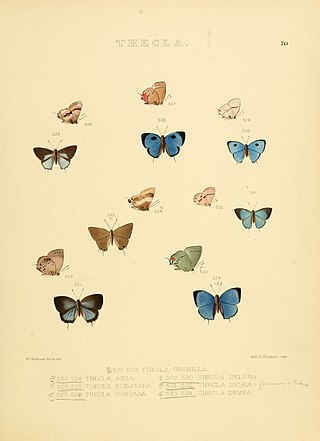
Electrostrymon is a genus of Neotropical butterflies in the family Lycaenidae.

Asterocampa celtis, the hackberry emperor, is a North American butterfly that belongs to the brushfooted butterfly family, Nymphalidae. It gets its name from the hackberry tree upon which it lays its eggs. The hackberry tree is the only host plant for A. celtis and is the food source for larvae.
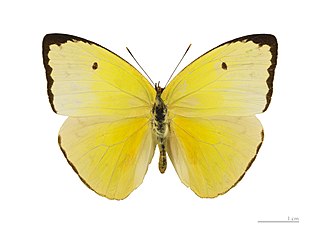
Aphrissa statira, the statira sulphur, is a species of Lepidoptera in the family Pieridae. The species is a medium-sized yellow butterfly, with females more pale than males. They are found from southern regions of Florida and Texas through southern Brazil and northern Argentina. The caterpillars feed on the leaves of several local host plants, while adults prefer to feed on the nectar of red or orange colored flowers. The species is most noted for their dramatic migrations in the tropical areas of the Americas. They have been the subject of many studies about how butterflies navigate and orient during migration.

Amblyscirtes vialis is a butterfly of the family Hesperiidae. It is found from British Columbia east across southern Canada to Maine and Nova Scotia, south to central California, northern New Mexico, Texas, the Gulf states and northern Florida.
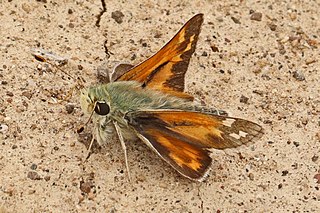
Hesperia juba, the Juba skipper, Yuba skipper, or jagged-border skipper, is a butterfly of the family Hesperiidae. It is found in North America from British Columbia, south to southern California, east to Montana, Wyoming, Colorado, and north-western New Mexico.
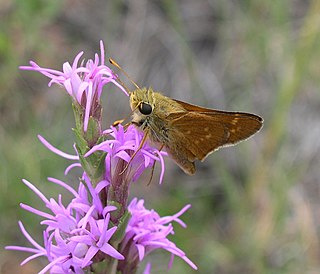
Hesperia leonardus, the Leonard's skipper, is a butterfly of the family Hesperiidae. There are three subspecies. Next to the nominate species, these are the Pawnee skipper, which is found in North America from western Montana and south-eastern Saskatchewan east to Minnesota, south to central Colorado and Kansas. Leonard's skipper ranges from Nova Scotia and Maine west through southern Ontario and the Great Lakes region to Minnesota, south to North Carolina, Louisiana and Missouri and the Pawnee montane skipper is endemic to the South Platte River drainage of Colorado.
Chlorostrymon telea, the telea hairstreak, is a butterfly of the family Lycaenidae. It was described by William Chapman Hewitsonin 1868. It is found from southern Texas and Mexico to Colombia, Uruguay, Paraguay, eastern Bolivia, Argentina and Chile. The habitat consists of stream valleys of semideciduous dry forests.
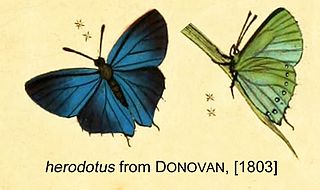
Cyanophrys herodotus, the tropical green hairstreak or tropical greenstreak, is a butterfly of the family Lycaenidae. It was described by Johan Christian Fabricius in 1793. It is found in Mexico, Guatemala, Panama, Nicaragua, Colombia, Ecuador, Peru, Bolivia, Brazil, Paraguay and Argentina. Rare strays can be found as far north as southern Texas. The habitat consists of open disturbed areas in tropical and subtropical rainforests and cloudforests at altitudes ranging from 600 to about 2,000 meters.

Strymon alea, the Alea hairstreak or Lacey's scrub-hairstreak, is a butterfly of the family Lycaenidae. It was described by Frederick DuCane Godman and Osbert Salvin in 1887. It is found from north-western Costa Rica through Mexico to central and southern Texas. The habitat consists of subtropical thorn scrub.

Electrostrymon angelia, the fulvous hairstreak, is a species of hairstreak in the butterfly family Lycaenidae. It is found in North America.

Electrostrymon denarius is a butterfly of the family Lycaenidae.
















